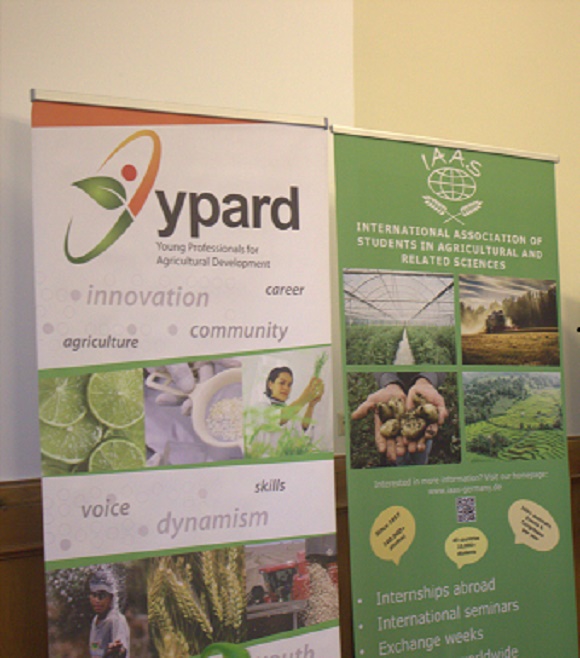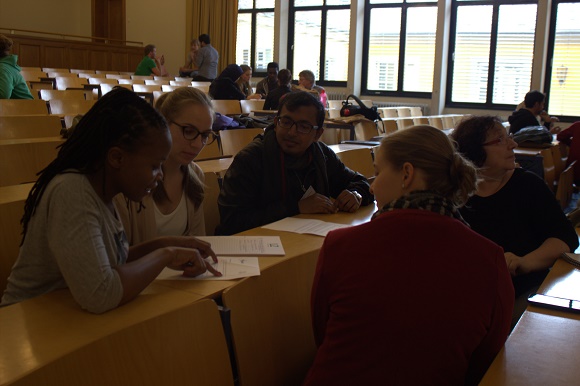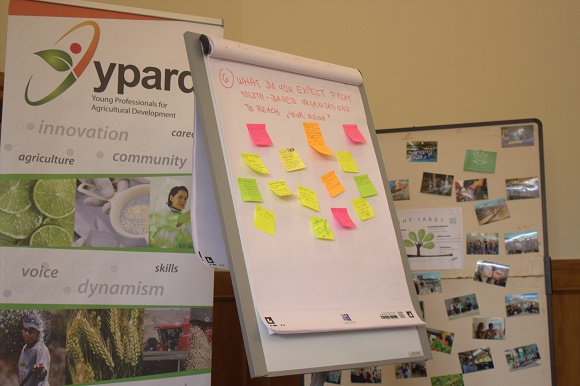-
About
- Our Work
- Get Involved
- Stay Updated
The youth perspective - how can we improve the position of youth in agriculture?
Building on the positive outcomes from the Young Professionals for Agricultural Development (YPARD) and the International Association of Students in Agricultural and Related Sciences (IAAS) Tropentag 2016 session YPARD Europe and IAAS Bonn decided to
 make it a tradition by organizing a second interactive session at Tropentag 2017 in Bonn, Germany.
make it a tradition by organizing a second interactive session at Tropentag 2017 in Bonn, Germany.The session focusing on the topic Supporting youth in agriculture: how can we improve the position of youth in the sector? was held on Tuesday, September 19th, 2017 as a part of the pre-conference workshop. It involved approximately 30 participants; mainly young agricultural professionals, youth networks, partners, researchers and other agricultural stakeholders.
To begin the interactive session YPARD Europe Coordinator Libuska Valesova and the Communications and Fundraising Officer Stacy Hammond as well as the IAAS World Vice President of Exchange Program Paulina Elena Manthey introduced the two platforms to the participants followed by an icebreaker where participants got to learn about each other and the motivations that led them to the agricultural sector thus, a better understanding of their vision(s) for agricultural development.
Small discussion groups were then formed to cover topics such as present realities of youth in agriculture and changes in the last ten years, actions present generation can take to improve the position of youth in the sector, different perceptions between different stakeholders, identify the crucial actions needed for active participation of youth in agriculture, youth expectations from youth-focused organizations in helping to reach their vision and what services provided by them are deemed most valuable.
Present realities of youth in agriculture
The group discussion started with reviewing the present realities of youth in agriculture all participants coming from different regions (Asia, Europe, Latin America, Africa) agreed that we all face similar realities in agriculture these may vary per region but overall the principle is the same. These may have changed over the past ten years and may be positive or negative.
Positive: highly developed technologies, large-scale farms, increase in youth participation, agriculture as a useful source of income, globalization.
 Negative: youth expectation of immediate impact, impatience for results, lack of connection between practical experience and research, rural communities versus subsistence farming, negative image of farmers by society, work conditions, bad image of agriculture, older generation (often) does not want to change, land ownership, parents want youth to have a better life by pursuing modern career options and lack of youth interest in agriculture.
Negative: youth expectation of immediate impact, impatience for results, lack of connection between practical experience and research, rural communities versus subsistence farming, negative image of farmers by society, work conditions, bad image of agriculture, older generation (often) does not want to change, land ownership, parents want youth to have a better life by pursuing modern career options and lack of youth interest in agriculture.The participants also divided the current realities per country highlighting that these positive or negative aspects are often dependent on the development status of each country, less developed: more dependent on production of their own food and the youth often see agriculture as a potential career choice mainly to improve their livelihood and contribute to the development of the sector in their countries. Participants agreed that the youth in developed countries are not interested/not motivated and do not see the advantages of agriculture focusing mainly on the earning gap and would prefer an academic career and see agriculture as a side activity, this has influenced the youth to move to cities.
Overcoming the negative realities of youth in agriculture - Primary drivers of change
 Six highlighted primary drivers and influencers of change were identified by participants to improve the realities of youth in agriculture and to make a change for the present and future generations.
Six highlighted primary drivers and influencers of change were identified by participants to improve the realities of youth in agriculture and to make a change for the present and future generations.- Globalization, market changes, climate change, sustainability, government involvement, more NGOs to support youth in the sector and to help improve the negative image of farmers.
- Consumers involvement and access to information, education system (agriculture should be taught in schools as a career option).
- Digitalization to boost the positive aspects/image of agriculture as we live in a world that is heavily influenced by the media and technology.
- Alternative small scale-farms (home gardening) to spark the interest of youth.
- Close the communication gap between farmers and researchers as well as the gap between students and practical experience as there is a low connection of research and practice.
- Encourage and promote the youth participation in the sector through all available channels.
Actions/strategies we can take to improving positions of youth in the sector
A series of feasible solutions/actions were given to draw youth to the sector. The actions were surrounded mainly on improving the image and highlighting the importance of agriculture as well as access to funding and resources. These actions were:
- Improve the image of agriculture through local and global channels

- Improve education access, start at an early age. Promote agriculture at schools by educating the youth and adults.
- Sharing experiences, knowledge and success stories (youth can have role models)
- Promote agriculture as a good source of income (get large stakeholders involved, funding and job opportunities as well as entrepreneurship).
- Keep the youth connected to food (access to local and global activities)
- Providing more information for consumers
- More space for small-scale farming
- Access to knowledge, training, career opportunities, better wages and access to money
- Involvement of institutions, collaborations, and partnerships
Expectations of youth from youth-based organizations
The expectations for youth based platforms such as YPARD and IAAS was also covered by the participants to determine how these platforms can contribute more to the issue of improving the position of youth in agriculture. The participants expressed that youth-focused agricultural organizations such as YPARD and IAAS should:
 Continue to make and promote videos, interviews, success stories and presentations in agricultural events to spread knowledge and improve the image of the sector, be a part of and promote the participation of different stakeholders (in discussions) and youth in agricultural and scientific events, focus on researchers and farmers not just students, Interact with organizations, associations share experiences, support each other, organize scientific sessions for young people, focus more on youth in rural areas, continue to motivate encourage and empower young people to take part in building the future and to engage in agriculture, create experiences around the world, share ideas while at the same time continue with local movement, put pressure on politics, give young people the chance to improve soft skills and practical skill, be present e.g. go to schools including elementary/high school pupils into project, create Young Farmers Club for teenagers, Think globally, act locally and last but not least be a bridge between student, researchers, farmers, and politicians.
Continue to make and promote videos, interviews, success stories and presentations in agricultural events to spread knowledge and improve the image of the sector, be a part of and promote the participation of different stakeholders (in discussions) and youth in agricultural and scientific events, focus on researchers and farmers not just students, Interact with organizations, associations share experiences, support each other, organize scientific sessions for young people, focus more on youth in rural areas, continue to motivate encourage and empower young people to take part in building the future and to engage in agriculture, create experiences around the world, share ideas while at the same time continue with local movement, put pressure on politics, give young people the chance to improve soft skills and practical skill, be present e.g. go to schools including elementary/high school pupils into project, create Young Farmers Club for teenagers, Think globally, act locally and last but not least be a bridge between student, researchers, farmers, and politicians.A big thank you to all participants for taking part in the YPARD/IAAS Tropentag 2017 session, we look forward to seeing you again next year at Tropentag 2018 in Gent, Belgium.
Picture credit: IAAS Bonn
About the author
Related Posts
Comments
No comments made yet. Be the first to submit a commentBy accepting you will be accessing a service provided by a third-party external to https://archive.ypard.net/
Get in touch
Email: [email protected]
YPARD Global Coordination UnitHosted by AGRIDEA and the Czech University of Life Sciences Prague
Lausanne, Switzerland and Prague, Czech Republic - Our Work

